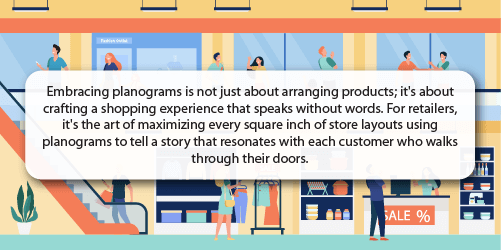When the conversation turns to optimizing store layouts, the questions often center on what retailers can do to maximize impact and efficiency. Planograms emerge as a pivotal tool in this quest, offering a strategic approach to arranging products to enhance aesthetic appeal and sales potential. For medium retailers, mastering planogram strategies is critical to transforming their store layouts into a powerful asset in the competitive market.

The 'why' behind meticulously crafted planograms is simple: they directly influence customer behavior and purchasing decisions. By strategically placing products using planogram strategies, retailers can guide the customer journey, spotlight key items, and create an inviting atmosphere that encourages exploration and purchase. This thoughtful organization boosts sales and elevates the overall shopping experience, making every square foot of the store count.
The 'how' unfolds through the strategic implementation of planograms, blending art with science to optimize store layouts. This involves analyzing customer behavior, leveraging space effectively, and continuously adapting to market trends. By embracing these principles, retailers can transform their planograms into a dynamic blueprint for success, setting the stage for the insightful exploration of maximizing store layouts.

Understanding the basics of planograms
Planograms are a fundamental tool in the retail industry, serving as detailed blueprints for arranging merchandise in a store. They are crucial for maximizing the aesthetic appeal and functionality of store layouts in retail spaces.
Understanding the basics of planograms is essential for retailers aiming to optimize their store layout and enhance customer experience through an effective planogram strategy.
But what is a planogram?
A planogram is a visual representation that details where and how retailers should place products on retail shelves or displays. Designed to provide a systematic layout for store layouts, they consider factors like product visibility, accessibility, and sales optimization as part of a comprehensive planogram strategy.
There are a few key elements to a planogram. These include:
Shelf space allocation
This involves determining how much shelf space each product receives. Retailers like Makro use planograms as part of their planogram strategy to allocate shelf space in their store layouts based on sales data, ensuring they give high-demand products prominence.
Product placement
This is about using planograms to position products in a way that maximizes visibility and attractiveness. For example, eye-level shelves are prime real estate in retail as they are at the customer's eye line, making products placed here more likely to be noticed and purchased.
Customer flow
Understanding how customers move and navigate through a store layout is crucial. Retailers like IKEA are known for their winding paths that guide customers through different sections, exposing them to a wide range of products.
Strategic grouping
Grouping related and complementary products, such as placing bread near spreads or the daily aisle next to coffee, teas, and biscuits, enhances the shopping experience by making it more convenient for customers to find what they need.
Visual appeal
The aesthetic aspect of a planogram, integral to enhancing store layouts, cannot be understated.
Attractive arrangements, balanced color schemes, and thematic displays significantly enhance the shopping environment.
All these elements show that planograms are more than just guides for shelf stocking; they are strategic tools that influence shopping behavior.
By optimizing product placement, they help in managing inventory, improving sales, and providing customers with a pleasant shopping experience. Retailers effectively utilizing planograms can expect to increase sales and improve customer satisfaction and loyalty.

Assessing a store's needs and goals
Understanding and assessing the specific needs and goals of a store is crucial for effective planogram implementation, particularly in optimizing store layouts. This process involves setting clear objectives for space optimization, sales targets, and enhancing customer experience.
Identifying store-specific needs
The first step is to evaluate the unique characteristics of the store. Factors such as store size, product range, and customer demographics play a significant role in determining planogram strategy for effective store layout optimization.
For example, a boutique store like Lush focuses on showcasing a limited range of products attractively, while a supermarket like Tesco needs to organize a vast number of items efficiently.
Setting goals for space optimization
Space optimization, a key aspect of planogram strategy, is about making the most of the available retail space. This involves strategically placing products to maximize visibility and accessibility while ensuring the store doesn't feel overcrowded.
Apple stores are an excellent example of space optimization, where products are displayed with ample space around them, creating a clean and open environment that encourages customers to interact with the products.
Establishing sales targets
Establishing sales targets is a fundamental aspect of planogram strategy, influencing the design and effectiveness of store layouts."
By analyzing sales data, retailers can identify high-performing products and allocate premium shelf space accordingly.
For example, pharmacy retailers Clicks or Dis-Chem might give more prominence to best-selling cosmetics, placing them at eye level or near the checkout area to boost impulse purchases.
Enhancing customer experience
Enhancing customer experience through planogram use involves creating a store layout that is visually appealing, functional, and easy to navigate.
IKEA excels in this area by designing a store layout that takes customers on a predetermined path through various sections, making the shopping experience comprehensive and enjoyable.
Regular reviews and adaptation
Regular reviews and adaptation of the planogram strategy are vital for retailers to keep their store layouts aligned with changing trends, customer feedback, and sales performance. This dynamic approach ensures the store remains relevant and appealing to customers.
For example, a fashion retailer might regularly update its layout to reflect the latest fashion trends and seasonal changes.
Assessing a store's specific needs and goals is critical in maximizing a store's layout. By focusing on space optimization, sales targets, and customer experience, retailers can create a store environment that not only looks good but also performs well in terms of sales and customer satisfaction.

Tools and techniques to design planograms
For medium-sized retailers, creating an effective planogram is a blend of art and science. It involves using various tools and techniques to maximize product visibility and accessibility, ultimately enhancing the shopping experience and boosting sales.
Understanding planogram software
The first step in designing a planogram for optimal store layouts is to choose the right software. Planogram software, like DotActiv, offers a digital platform to create, manage, and optimize retail space.
This tool provides a visual representation of the store layout, allowing retailers to experiment with different arrangements without physically moving products.
Analyzing sales data
Utilizing sales data is crucial in planogram strategy and design. Retailers can identify which products are high sellers and should be given prime placement.
For example, a grocery store might use sales data to determine that organic products are popular among its customers and place them at eye level for easy access.
Customer flow and product placement
Understanding customer flow within the store is key to an effective planogram strategy. The goal is to guide customers through the store in a way that maximizes exposure to products.
Retailers can use techniques like the 'right-hand rule', where customers naturally turn right upon entering a store, to place high-demand or high-margin products strategically.
Visual merchandising techniques
Visual merchandising plays a significant role in planogram design, enhancing the aesthetics and functionality of store layouts. Techniques such as color blocking, where similar colors are grouped, or thematic displays can draw attention to specific products or promotions.
For example, a clothing retailer might use color blocking to create visually appealing displays to highlight seasonal trends.
Flexibility and adaptability
An effective planogram is dynamic and vital for maintaining flexible and adaptable store layouts. It should be flexible and adaptable to changes in consumer trends, seasonal demands, or new product launches.
Regularly updating the planogram ensures the store remains dynamic and engaging.
An electronics retailer like InMotion, for example, might update its planogram strategy to feature the latest gadgets prominently.
Collaboration with suppliers
Collaborating with suppliers is beneficial for enriching planogram strategies and refining store layouts.. Suppliers often have insights into product performance and may offer suggestions or even specific planogram layouts. This collaboration can lead to mutually beneficial arrangements, such as dedicated display areas for specific brands.
Designing a planogram involves combining strategic planning, data analysis, and visual merchandising. By effectively utilizing planogram tools and techniques, retailers can create a store layout that looks good, drives sales, and improves the customer experience.

Implementing planograms in-store
Planogram implementation is a critical step in maximizing store layouts. This process involves careful planning and execution to ensure that the store's layout aligns with its overall theme, branding, and customer needs.
Prepare the store layout
Before implementing the planogram, it's essential to prepare the store layout, ensuring it aligns with the store’s theme and branding. This includes cleaning shelves, removing old signage, and ensuring the space is ready for a new arrangement.
Retailers should also consider the store's overall theme and branding during this stage. For example, a health food store like Wellness Warehouse might opt for a natural and minimalistic design to align with its brand identity.
Organize products
The next step is to organize products according to the planogram strategy. This involves grouping products in a way that makes sense for the customer.
For example, a medium-sized bookstore might group genres, making it easier for customers to find the books they are interested in. It's critical to place best-selling or high-margin products in prominent positions, such as at eye level or near the checkout area.
Shelf arrangement
Shelf arrangement is also crucial in planogram implementation, as it plays a key role in the effectiveness of the store layout.
Retailers should arrange their shelves to maximize product visibility and accessibility. Retailers can use different shelving heights and depths to create an engaging and dynamic display.
For example, a clothing store might use varied shelving to display folded clothes, accessories, and mannequins attractively.
Signage and pricing
Clear signage and pricing are essential for a positive customer experience. Signs should be easy to read and consistent with the store's branding. Price tags should be visible and updated according to the planogram.
For example, a hardline retailer like Midas might use large, bold signs to guide customers to different sections. Keep in mind this isn't retailer-specific.
Consistency and maintenance
Post-implementation, maintaining consistency is critical for the success of the planogram in the store layout. This means regularly checking that products are in their correct place and that the store remains tidy and organized.
Regular maintenance ensures that stores meet the planogram's objectives while remaining appealing to customers.
Gather feedback and make adjustments
Gathering feedback from customers and staff can provide valuable insights for refining the planogram strategy and enhancing the store layout. Retailers should adjust based on this feedback to continually improve the store layout and customer experience.
Implementing a planogram in-store requires careful planning, organization, and maintenance. Following these steps means retailers can create an appealing store layout that enhances the shopping experience and drives sales.

Monitoring and adapting planograms
After implementing a planogram, it's crucial to monitor its performance and adapt it based on sales data, customer feedback, and evolving market trends.
This ongoing process ensures that the store layout remains effective and relevant.
Tracking sales performance
The primary indicator of planogram strategy success is its impact on sales as it is a direct reflection of its impact on optimizing store layouts. Retailers should closely monitor sales data to understand which products are performing well and which are not.
For example, a medium-sized cosmetic store might find that certain skincare products sell faster than anticipated, indicating a need to allocate more shelf space.
Analyzing customer traffic and behavior
Understanding customer traffic patterns and behavior within the store can provide valuable insights into fine-tuning the planogram strategy for effective store layouts. Retailers can use tools like heat maps or customer surveys to gather this information.
For example, a medium-sized apparel store might discover that customers spend more time in the casual wear section, suggesting a potential area for expansion.
Gathering customer feedback
Direct feedback from customers is an invaluable aspect of evolving a planogram strategy. Retailers can use comment cards, online surveys, or face-to-face interactions to gather opinions on the store layout, product assortment, and overall shopping experience.
An electronics retailer, for example, might learn from customer feedback that the layout is too crowded, prompting a redesign for better navigation.
Adapting to changing trends
Consumer trends can change rapidly, and retailers must be agile enough to adapt their planograms accordingly to ensure that store layouts remain relevant and appealing. This could involve introducing new product lines, changing the layout to highlight seasonal items, or incorporating new display techniques.
For example, a medium-sized home decor store might update its planogram seasonally to showcase different home styling trends.
Regular review and update
Planograms should not be static; they need regular review and updates. This process involves reassessing the store layout, product placement, and visual merchandising elements to ensure they align with current sales objectives and customer preferences.
For example, a medium-sized bookstore might rotate its displays monthly to highlight new releases and bestsellers.
Collaborating with staff
Staff members are often the first to notice customer behavior changes and preferences. Collaborating with staff offers valuable insights for refining the planogram strategy and improving the store layout, leading to more informed decisions about planogram strategy adjustments.
Conclusion
Effectively utilizing planograms is crucial for retailers aiming to maximize their store layouts and enhance customer experience and sales. Experience the transformative power of DotActiv's software, equipped with intuitive design tools and insightful analytics.
Download our free 14-day trial and witness the positive impact on your retail space firsthand.


